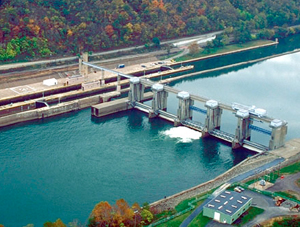 |
 |
|
| eNews • January 2013 | ||
| Promoting a Cost-Effective, Reliable and Competitive Transportation System |
||
 Locks and Dams: Time for Fresh Thinking?
Locks and Dams: Time for Fresh Thinking?
Our nation’s inland waterway system, including our inventory of locks and dams, is not simply a contributing factor to the success of U.S. soybean farmers, it is a dominant one. Other countries can produce soybeans at a lower price. However, it has been and continues to be the ability to deliver those soybeans to our customers in a cost-effective manner that helps U.S. soybean farmers maintain a competitive advantage. For much of the key soybean growing regions of the country, barge transportation is the most economical, efficient mode for transporting soybeans to our export terminals.
Despite the widespread acknowledgement of the importance of our inland waterway system to the viability of the U.S. economy overall, including the soybean industry, the condition of our lock and dam inventory continues to degrade. Significant time, energy, and resources have been devoted by agriculture and other stakeholders to promote increased investment in the system, yet progress remains elusive. A recent study funded by the soybean checkoff suggests that it may be time to reevaluate how our nation manages and finances our lock and dam inventory.
“The Soy Transportation Coalition and many others who are gravely concerned with the condition of our inland waterway system are concluding that there is a need for fresh thinking to be incorporated into this important issue,” explains Mike Steenhoek, executive director of the Soy Transportation Coalition. “Abiding by the same strategy will most assuredly yield the same results.”
The study, “New Approaches for U.S. Lock and Dam Maintenance and Funding,” was performed by the Texas Transportation Institute at Texas A&M University. The analysis highlights many of the inadequacies of the current efforts of managing our lock and dam system and how alternative funding and maintenance strategies have the potential to yield better results.
One of the key deliverables from the study is comparing major maritime infrastructure projects in other countries with those in the U.S. – particularly in the ability to complete projects on time and within budget. The Panama Canal expansion and the construction of the Deurganck Lock at the Port of Antwrep were specifically highlighted. “It is discouraging to observe how many other countries are able to construct their major infrastructure projects much more efficiently than we can,” says Steenhoek. “Many of these projects are more imposing and complex than any project we have underway or planned in our inland waterway system, yet these projects are completed within budget and on schedule. Compare this to our Olmsted Lock and Dam project that had an original cost estimate of $775 million and has recently been updated to over $3.1 billion with a significant time horizon remaining before it will be completed. When examining the various reasons for our repeated cost overruns and project delays, it quickly becomes evident that a major contributing factor is the piecemeal and unpredictable manner in which we finance these projects.”
Major investments of any nature – particularly infrastructure investments – require a system of funding that provides the money up front in a lump sum, or at least provides certainty that the incremental installments will be allocated. Our current system provides neither. The research cited the McAlpine Lock and Dam project on the Ohio River, near Louisville, and how it received, on average, only 61 percent of full capability funding levels. The study identifies how such an unpredictable and insufficient funding stream resulted in a 38 percent cost escalation and a project completion delay of 6 and a half years.
The analysis further examines the feasibility of instituting a bonding style approach to lock and dam financing. If implemented, priority projects could achieve greater funding in an initial lump sum – decreasing the likelihood of the cost overruns and delays pandemic among our lock and dam system. “Our research highlights that how you allocate money is just as important as how much money is allocated,” explains Steenhoek. “A bigger check from the government is not the only solution. Better stewardship is also essential.”
“The other major principle advanced in our analysis is that a predictably good inland waterway system is better than a hypothetically great one,” says Steenhoek. “During this period of fiscal scarcity, we are concerned that our nation is failing not only in providing new and expanded locks and dams, but also in maintaining and preserving our current inventory. A preferable approach may be to first demonstrate stewardship of current locks and dams by providing assurance to users that a lock and dam, in the event of a major failure, will be operational within 48 or 72 hours, for example. If we allocate our resources in a manner that provides this degree of predictability to those who utilize our inland waterway system, we believe that will provide a superior message to the one we are currently sending.”
According to the research, the cost of one lock construction project ($376.8 million) is approximately equal to the cost of nine major rehabilitation projects ($40.7 million). If each of the nine new construction/expansion projects currently underway were downgraded to a major rehabilitation, their total cost would drop to $366.3 million compared to the listed total of $3.2 billion – a difference of $2.8 billion.
Steenhoek explains, “We recognize this is a departure from the longstanding promotion, among agriculture and other stakeholders, of new, expanded locks with auxiliary chambers. We share this desire, but the question we posed ourselves is, “Is continuing this strategy likely to yield results, or will it simply perpetuate the lack of progress we’ve witnessed for years?”
The full results of the study can be accessed at www.soytransportation.org or www.unitedsoybean.org.
Soy Transportation Coalition |
|
